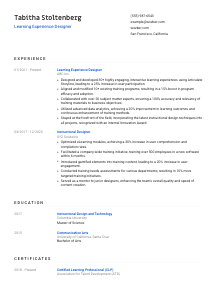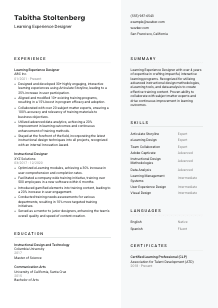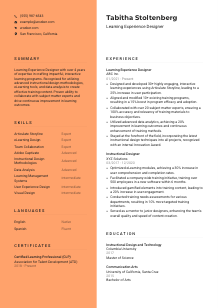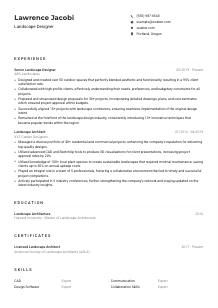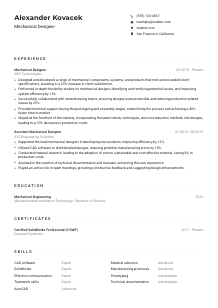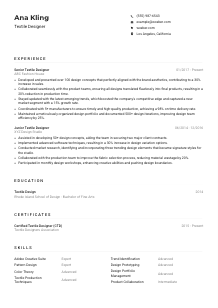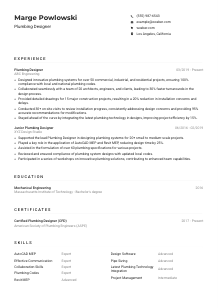Learning Experience Designer CV Example
Crafting dynamic learning paths, but your CV feels stuck in a lecture? Explore this Learning Experience Designer CV example, molded with Wozber free CV builder, to see how you can outline your experiential expertise to match job expectations, ensuring your career growth isn't just marked by attendance!
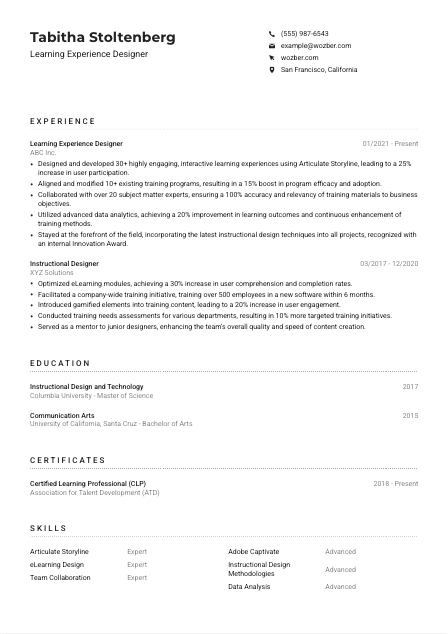
How to write a Learning Experience Designer CV?
Hello, aspiring Learning Experience Designer! Preparing to step into an exciting role requires more than just experience and passion; it demands that you present your best self on paper. Your CV isn't just a formality; it's your personal billboard. Using Wozber's free CV builder, we'll guide you through creating a CV that meets the unique demands of the Learning Experience Designer position.
Ready to transform your professional story into an invitation for an interview? Let's make your CV not just noticed, but remembered.
Personal Details
The 'Personal Details' section is where your journey begins on the CV. It's more than just your name and contact; it's where you set the expectation. By custom-tailoring this section for the Learning Experience Designer role, you ensure precision alignment with the job's prerequisites.
1. Name: Your Personal Brand
Your name is your personal brand, heralding the rest of your CV. Ensure it's in a clean, readable font, possibly a tad larger than the rest of the text to stand out. This isn't just about aesthetics; it's about ensuring your name is memorable at a glance.
2. Direct Alignment with the Job Title
Matching your title with the job you're applying for, like 'Learning Experience Designer,' instantly bridges your experience with what the hiring team is looking for. It shows you're not just casting a wide net but are focused and informed about your career path.
3. Essential Contact Details
Details matter. Ensure your contact information, including a professional email address (think firstname.lastname@email.com) and a reliable phone number, is correct and current. It's a small detail that speaks volumes about your attention to detail.
4. Location Matters
Being in the right place can be as critical as having the right skills. By mentioning "San Francisco, California", you're ensuring a seamless match with the job location requirement, confirming that you're a practical choice without the need for relocation.
5. Adding a Professional Profile
A link to a professional online profile, like LinkedIn, can provide a deeper insight into your professional world. Ensure it's updated and reflects the same information as your CV to maintain consistency and professionalism.
Takeaway
Think of the 'Personal Details' as your initial handshake with the hiring manager. It's your chance to make a memorable first impression. By ensuring each detail is meticulously aligned with the Learning Experience Designer role, you're setting the stage for a deeper engagement with the rest of your CV. Let this section pave the way for your professional story.





Experience
As a Learning Experience Designer, your experience section is where you truly shine. Here we'll delve into crafting this crucial segment to reflect the nuances and depth of your role, directly mirroring the job requirements.
- Designed and developed 30+ highly engaging, interactive learning experiences using Articulate Storyline, leading to a 25% increase in user participation.
- Aligned and modified 10+ existing training programs, resulting in a 15% boost in program efficacy and adoption.
- Collaborated with over 20 subject matter experts, ensuring a 100% accuracy and relevancy of training materials to business objectives.
- Utilized advanced data analytics, achieving a 20% improvement in learning outcomes and continuous enhancement of training methods.
- Stayed at the forefront of the field, incorporating the latest instructional design techniques into all projects, recognized with an internal Innovation Award.
- Optimised eLearning modules, achieving a 30% increase in user comprehension and completion rates.
- Facilitated a company‑wide training initiative, training over 500 employees in a new software within 6 months.
- Introduced gamified elements into training content, leading to a 20% increase in user engagement.
- Conducted training needs assessments for various departments, resulting in 10% more targeted training initiatives.
- Served as a mentor to junior designers, enhancing the team's overall quality and speed of content creation.
1. Dissecting the Job Description
Begin by thoroughly analyzing the job description. Highlight elements like ‘design and develop engaging learning experiences' and ‘utilize data to improve learning outcomes'. These are your keywords and phrases, beacons that guide how you present your experience.
2. Structured Presentation
Organize your experience in a reverse chronological order. For each role, clearly list your title, the company's name, and your tenure. This direct, clutter-free approach ensures a smooth, intuitive reading experience for the hiring team.
3. Crafting Impactful Accomplishments
For every position you've held, especially the most recent ones, highlight how you "designed and developed 30+ highly engaging, interactive learning experiences" or "Collaborated with over 20 subject matter experts." These accomplishments show you're not only experienced but effective.
4. Quantifying Your Impact
Numbers speak louder than words. By quantifying your achievements, like "leading to a 25% increase in user participation," you provide tangible proof of your effectiveness and capacity to contribute positively to your future employer's goals.
5. Relevancy Is Key
In the vibrant field of learning experience design, not every experience might relate directly to the job you're applying for. Focus on articulating the experiences that showcase your eligibility for this specific role. Remember, precision beats volume.
Takeaway
Your experience section is a powerful narrative of your professional journey. By carefully aligning each point with the job description, you're not only asserting your qualifications but also demonstrating your potential impact. Let your experiences weave a tale of success, innovation, and the perfect fit for the Learning Experience Designer role.
Education
Education lays the groundwork for your skills and knowledge. For the Learning Experience Designer role, showcasing your educational background with precision can significantly underscore your competence for the position.
1. Identifying Essential Education
First, pinpoint what the job posting explicitly requires for educational background. For this role, highlight your "Bachelor's degree in Instructional Design, Education, or related field," directly meeting one of the crucial prerequisites.
2. Simplify the Structure
Present your education succinctly: list your degree, followed by your field of study, the institution, and graduation year. This straightforward layout allows hiring managers to quickly confirm your qualifications without sifting through unnecessary details.
3. Aligning Your Degree
Your degree speaks volumes about your expertise. For instance, "Master of Science in Instructional Design and Technology" precisely aligns with the specialized knowledge expected for a Learning Experience Designer, significantly bolstering your CV.
4. Relevant Coursework (If Applicable)
In scenarios where specific courses directly contribute to your qualification for the role, don't hesitate to list them. Though not always necessary for seasoned professionals, it can be particularly advantageous for recent graduates or those transitioning to new fields.
5. Additional Academic Achievements
Were you the part of an instructional design club? Did you lead an educational project that won accolades? Such achievements, while not always central, can add a layer of interest to your profile, illustrating your passion and engagement in your field.
Takeaway
In essence, your education section is more than dates and degrees; it's a testament to your foundational knowledge and your journey in becoming the Learning Experience Designer you are today. Ensure it resonates deeply with what the role demands, underlining your readiness to make a significant impact.
Certificates
In the fast-evolving domain of learning design, certificates are your badges of honor. They signal your commitment to stay ahead, adapt, and excel. Let's explore how to present them in a way that highlights your ongoing mastery.
1. Reflecting Job Requirements
The job might not always specify required certifications, but when it does, or even when it hints at preferred qualifications, aligning your certifications with these preferences showcases your dedication and foresight.
2. Prioritizing Relevance
Highlight certificates that speak directly to the Learning Experience Designer role, such as "Certified Learning Professional (CLP)." This prioritization makes your CV a focused reflection of your suitability for the position.
3. Dates Matter
If applicable, include the issuance and, if pertinent, expiration dates of your certifications. It's a small detail that communicates the currency and relevance of your knowledge and skills.
4. Embracing Lifelong Learning
The learning design landscape continually shifts with new methodologies and technologies. Show that you're not just keeping up but are ahead of the curve by constantly updating your certifications and seeking new learning experiences.
Takeaway
Certificates are tangible evidence of your professional growth and dedication. They add depth to your CV, highlighting your commitment to excellence in the Learning Experience Design field. Present them proudly, let them recount your journey of continuous improvement and insatiable curiosity.
Skills
In the world of learning experience design, your skills constitute the toolbox that allows you to create, innovate, and impact. Understanding how to align them with the job requirements is crucial. Here's how to refine your skills section into a compelling showcase
1. Matching Job Specifications
Begin with a laser focus on the job description. Skills like "proficiency in eLearning authoring tools" and "strong understanding of adult learning theories" are your compass, guiding you to highlight the abilities that speak directly to the job's needs.
2. Prioritizing Pertinent Skills
In the Learning Experience Designer role, both hard skills like "Articulate Storyline" and soft skills such as "excellent communication" are equally vital. List them comprehensively but prioritize according to the job description's emphasis.
3. Clarity and Organisation
Resist the temptation to overload this section. A well-organized, selective presentation of skills—particularly those backed by achievements in the experience section—creates a sharper, more impactful statement about your qualifications.
Takeaway
This section is an opportunity to assert that you're not just capable but exceptionally equipped for the role at hand. Highlight your skills with precision, backed by proof from your professional journey, making your aptitude undeniable. Let your skills do the talking, eloquently mapping your expertise to the Learning Experience Designer position.
Languages
In an interconnected world, your ability to communicate across languages can be a powerful asset, especially in roles engaging with diverse learning audiences. While the job might necessitate fluency in English, your multilingual prowess can set you apart.
1. Complying with Job Needs
Start by ensuring your CV explicitly states your proficiency in English, aligning with the job's requirement for "Fluent English speaking and writing skills." It's not just about meeting expectations but about demonstrating your ease in the primary medium of communication.
2. Showcasing Additional Languages
Beyond the essentials, list any other languages you're fluent in. This additional skill can enrich your value, especially in roles that may involve creating learning experiences for multilingual audiences or collaborating with global teams.
3. Transparency in Proficiency
Clearly indicating your level of proficiency in each language you list showcases honesty and self-awareness. Whether you're 'Native', 'Fluent', 'Intermediate', or 'Basic', clarity here helps set realistic expectations.
4. Understanding the Role's Scope
In roles with an emphasis on collaboration and inclusivity, showcasing your linguistic versatility could be particularly advantageous. It's not just about what you know, but how you can connect and communicate that knowledge effectively to others.
5. The Global Perspective
Given the global scope of many educational projects, your ability to navigate multiple languages can be an invaluable asset. It's about bringing the world closer, one learning experience at a time. Your linguistic skills are a testament to your capability to do just that.
Takeaway
Your linguistic capabilities are more than a personal asset; they're a professional strength. By strategically presenting your language skills, you emphasize your ability to engage, communicate, and resonate across diverse cultures. Let your CV reflect your role as a bridge-builder in the realm of learning experience design.
Summary
The summary section is like the cover of your book – it needs to entice the reader into wanting to know more. For a Learning Experience Designer, crafting a persuasive summary is about painting a vibrant picture of your professional narrative.
1. Capturing the Job's Essence
Absorb the job description fully. Recognizing that you're expected to "design and develop engaging learning experiences" is just the start. Use this understanding to succinctly present yourself not just as a candidate, but as the solution to their needs.
2. Setting the Introduction
Begin with a strong opening line that highlights your professional standing and immediate relevance to the role. For instance, mentioning over 4 years of experience in crafting impactful, interactive learning programs positions you as an experienced professional right from the start.
3. Reflecting Key Attributes
Pinpoint and include a mix of hard and soft skills that directly align with the job's demands. When you mention your expertise in "utilizing advanced instructional design methodologies", it directly resonates with one of the core requirements of the role.
4. Brevity with Impact
Though it's tempting to include every achievement, the summary is not the place for it. Keep it punchy, focusing on 3-5 lines that encapsulate your expertise, approach, and the unique impact you'll bring to the role.
Takeaway
The summary is your chance to condone a strong first impression, making the hiring manager curious to dive deeper into your CV. It's about striking the right balance between brevity and substance, ensuring that your opening narrative is as captivating as it is compelling. Let it be a window to your professional soul, inviting a closer look.
Your Journey to Becoming a Learning Experience Designer
Congratulations on completing your guide to crafting a CV that speaks volumes about your suitability for the Learning Experience Designer role. With each section tailored to the nuances of the position, your CV is now a powerful testament to your skills, experience, and passion. Remember, the CV you've constructed isn't just a list of accomplishments—it's your personal narrative, designed to engage, resonate, and ultimately, to open doors to new opportunities.
With Wozber's free CV builder at your side, including ATS-friendly CV templates and an ATS CV scanner for optimisation, you're well-equipped to take the next step. Go forth with confidence; your next big role awaits.

- Bachelor's degree in Instructional Design, Education, or a related field.
- Minimum of 3 years' experience in instructional design, curriculum development, or a similar role.
- Proficiency in eLearning authoring tools such as Articulate Storyline, Adobe Captivate, or similar platforms.
- Strong understanding of adult learning theories, instructional design methodologies, and learning management systems.
- Excellent communication and collaboration skills, with the ability to work closely with subject matter experts and stakeholders.
- Fluent English speaking and writing skills necessary.
- Must be located in San Francisco, California.
- Design and develop engaging, interactive learning experiences for both digital and in-person delivery.
- Evaluate and modify existing training programs to align with organization's goals and objectives.
- Collaborate with subject matter experts to ensure accuracy and relevancy of training materials.
- Utilize data and feedback to continuously improve learning experiences and measure learning outcomes.
- Stay updated with the latest instructional design techniques and technologies to incorporate them into training programs.





